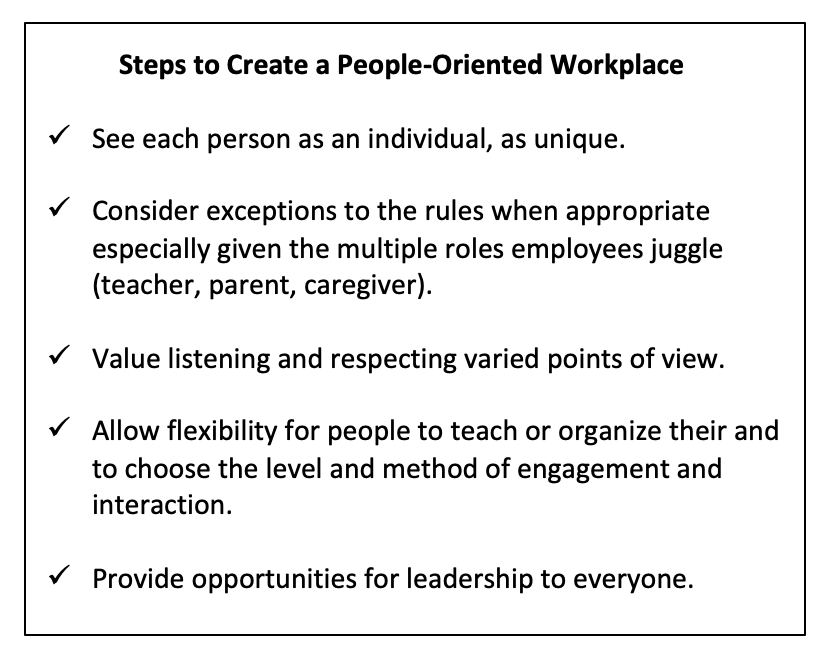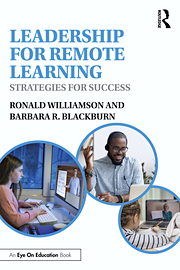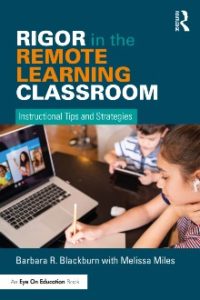7 Teacher Supports During Stressful Times
By Ronald Williamson and Barbara Blackburn
 Working in education often feels like a rollercoaster – it has ups and downs and even some startling dips and turns. But the past two years have had more turbulence than most of us can remember and it’s had a major impact on educators.
Working in education often feels like a rollercoaster – it has ups and downs and even some startling dips and turns. But the past two years have had more turbulence than most of us can remember and it’s had a major impact on educators.
 Across the country the pandemic upheaval and the politicization of education is taking a toll on teacher morale. Teacher turnover has risen dramatically with increased retirements and a growing number of younger teachers considering leaving the profession (Zamarro, Camp, Fuchsman & McGee, 2021).
Across the country the pandemic upheaval and the politicization of education is taking a toll on teacher morale. Teacher turnover has risen dramatically with increased retirements and a growing number of younger teachers considering leaving the profession (Zamarro, Camp, Fuchsman & McGee, 2021).
Adding to the turmoil is a shortage of substitute teachers, bus drivers and other personnel as well as an inconsistent policy response to the pandemic at every level of decision-making, raising health and safety concerns for students and educators.
In some districts classes are cancelled or moved to remote learning on short notice because of an inability to staff schools. In other schools waves of quarantine events create an unstable teaching environment and shatter instructional continuity.
All of this has increased anxiety among educators about the state of their personal as well as professional lives. “Overwhelmed” and “burned out” are words we are all hearing teachers say.
Three stress-related statistics illustrate the depth of the issue.
- 83% of employees experience early signs of burnout;
- 25% of employees experience the most severe signs of burnout, which include poorer performance, cynicism toward colleagues, and apathy for the workplace; and
- 71% of employees say workplace stress affects their mental health.
Source: McGovern (2021). 6 ways to help employees deal with stress.
It’s important to recognize the challenges of these uncertain times, during which teachers and staff can experience social isolation – disconnected from one another and from their principal. They are often on the frontline when dealing with parents and, in many cases, are openly challenged about their decisions and their work with students in person and in social media.
These challenges are real, and school leaders must take them seriously and support their faculties and staff.
How can we best support our people?
Here are seven actions we recommend to give teachers and staff our full support right now. These are actions that define effective educational leadership all the time, but we feel it’s important to restate and reflect on them amid all the current stressors and uncertainty.
1. Don’t Minimize the Problem
The most important response it to take the issue seriously. Don’t minimize the impact of the pandemic, and related issues, on teachers and other employees. Talk openly with individuals, and with your staff, about the stress they face and the emotions they are experiencing.
Recognize that individuals respond differently to stress and that your response will need to vary with the individual. Encourage staff to maintain an appropriate work-life balance. Model that balance in your own life, and make sure you don’t increase expectations that will intrude on employees’ personal and family time.
2. Set Boundaries for Parents/Families
Be clear with your parents and other stakeholders about appropriate boundaries. Share appropriate ways to contact teachers and make sure you are explicit – with both teachers and parents – that you do not expect teachers to work 24/7 or provide a response to queries outside of the work day.
3. Establish Varied Ways to Connect
Be clear about how you will connect with your team. One school used videoconferencing for check-in’s and other meetings but agreed to use texting when something was urgent. Also be clear about expectations for sharing information among your teachers. Identify a time during the day when employees can reach you.
4. Provide Key Information in Predictable Ways
Faculty can be overwhelmed by information and often feel as though they are missing key information because it’s lost in the details. Provide regular updates in a predictable format even if you have little to update.
Communication is one way to maintain connections not only with but among employees. Make elements of your communication routine, like a weekly Covid Update or What’s Up bulletin. Remember that surprise actions add to stress and anxiety.
Parts of what you share may be repetitious, with reminders of important safety protocols and such, but use each update to provide information on how decisions will be made to modify the instructional mode, deal with staff shortages, and other urgent questions. And, of course, share good news from across the campus.
5. Use Multiple Communication Tools
 Mass emails to the entire faculty can distribute information quickly, but they are often insufficient and the key messaging gets lost. Become familiar with, and use, a variety of communication strategies. One study found that people will be more engaged, and interactive, when talking face-to-face or video conferencing. These and other tools (podcasts, livestream, etc.) provide visual and voice cues and reduce the sense of isolation. They are far more personal than email or other written communication.
Mass emails to the entire faculty can distribute information quickly, but they are often insufficient and the key messaging gets lost. Become familiar with, and use, a variety of communication strategies. One study found that people will be more engaged, and interactive, when talking face-to-face or video conferencing. These and other tools (podcasts, livestream, etc.) provide visual and voice cues and reduce the sense of isolation. They are far more personal than email or other written communication.
6. Monitor Non-Verbal Behavior
During in-person meetings we are able to pay attention to non-verbal feedback; in online meetings tone and voice serve as proxies for some people. The infletion or pitch of the voice or even the frequency of comments can indicate the employee is experiencing some anxiety.
People have different levels of engagement in individual or team meetings. Be looking for changes in behavior. Is an employee less engaged than normal? Pay attention to non-verbals and adjust your expectations based on what you observe. Talk with others on your team to make sure you are interpreting things accurately.
7. Offer Encouragement and Emotional Support
The research on emotional intelligence and emotional contagion says that employees look for cues about how to react to changes, whether that is COVID, criticisms from the community about curriculum, or staffing concerns. If you communicate stress, that will “trickle-down” to your employees (Goleman, 2005).
It is important to acknowledge the stress and anxiety that can come from these issues. Listen to your employees and empathize with their concerns. Always listen carefully and let the employee’s concerns be the focus of the conversation rather than your own. Also provide affirmation and express confidence in your team.
 Be visible and proactive
Be visible and proactive
How do we move forward in addressing these issues? Start by modeling your own stress-relieving and work-life balance strategies. Show that you have empathy and understand what others are experiencing.
Next, share good news whenever possible (but avoid “toxic positivity”) to help balance the negative feelings that can occur during crises and times of transition. Help your teachers and staff access appropriate mental health resources in a non-threatening manner.
Finally, remove any barriers to their success. If a teacher is frustrated that she doesn’t have time to make copies or put up a bulletin board, find a parent or community volunteer who is willing to help. If a new teacher is overwhelmed, pair him with an experienced teacher to help with planning, and with a newer teacher to provide “closer to home” encouragement.
As you interact with your faculty and staff, always look for ways to support their work and reduce their stress and anxiety. Pay attention. Let them see your commitment to them as well as to your students and community.
References
Goleman, D. (2005). Emotional intelligence: Why it can matter more than IQ. Bantam Books.
McGovern, M. (2021). 6 ways to help employees deal with stress.
Zamarro, G, Camp, A., Fuchsman, D, McGee, J. (2021). Pandemic prompts more teachers to consider retirement or new career. The Conversation
 Dr. Ronald Williamson is Professor Emeritus of Educational Leadership at Eastern Michigan University. He is a former principal, central office administrator and executive director of the National Middle School Association (now AMLE). The author of numerous books on leadership, he is the co-author with Barbara R. Blackburn of Leadership for Remote Learning (2021) and 7 Strategies for Improving Your School (2020), both from Routledge/Eye On Education.
Dr. Ronald Williamson is Professor Emeritus of Educational Leadership at Eastern Michigan University. He is a former principal, central office administrator and executive director of the National Middle School Association (now AMLE). The author of numerous books on leadership, he is the co-author with Barbara R. Blackburn of Leadership for Remote Learning (2021) and 7 Strategies for Improving Your School (2020), both from Routledge/Eye On Education.
 Dr. Barbara R. Blackburn, a “Top 30 Global Guru in Education,” is a bestselling author of over 25 books and a sought-after consultant. She was an award-winning professor at Winthrop University and has taught students of all ages. In addition to speaking at conferences worldwide, she regularly presents virtual and on-site workshops for teachers and administrators. Barbara is the author of Rigor in the Remote Learning Classroom: Instructional Tips and Strategies from Routledge/Eye On Education.
Dr. Barbara R. Blackburn, a “Top 30 Global Guru in Education,” is a bestselling author of over 25 books and a sought-after consultant. She was an award-winning professor at Winthrop University and has taught students of all ages. In addition to speaking at conferences worldwide, she regularly presents virtual and on-site workshops for teachers and administrators. Barbara is the author of Rigor in the Remote Learning Classroom: Instructional Tips and Strategies from Routledge/Eye On Education.


































